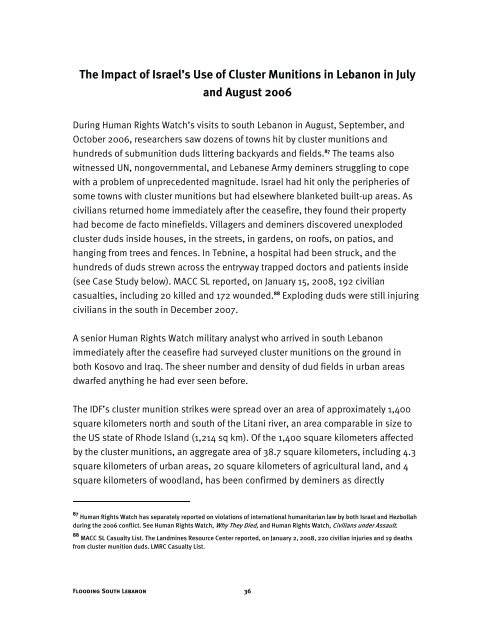Flooding South Lebanon - Human Rights Watch
Flooding South Lebanon - Human Rights Watch
Flooding South Lebanon - Human Rights Watch
Create successful ePaper yourself
Turn your PDF publications into a flip-book with our unique Google optimized e-Paper software.
The Impact of Israel’s Use of Cluster Munitions in <strong>Lebanon</strong> in July<br />
and August 2006<br />
During <strong>Human</strong> <strong>Rights</strong> <strong>Watch</strong>’s visits to south <strong>Lebanon</strong> in August, September, and<br />
October 2006, researchers saw dozens of towns hit by cluster munitions and<br />
hundreds of submunition duds littering backyards and fields. 87 The teams also<br />
witnessed UN, nongovernmental, and Lebanese Army deminers struggling to cope<br />
with a problem of unprecedented magnitude. Israel had hit only the peripheries of<br />
some towns with cluster munitions but had elsewhere blanketed built-up areas. As<br />
civilians returned home immediately after the ceasefire, they found their property<br />
had become de facto minefields. Villagers and deminers discovered unexploded<br />
cluster duds inside houses, in the streets, in gardens, on roofs, on patios, and<br />
hanging from trees and fences. In Tebnine, a hospital had been struck, and the<br />
hundreds of duds strewn across the entryway trapped doctors and patients inside<br />
(see Case Study below). MACC SL reported, on January 15, 2008, 192 civilian<br />
casualties, including 20 killed and 172 wounded. 88 Exploding duds were still injuring<br />
civilians in the south in December 2007.<br />
A senior <strong>Human</strong> <strong>Rights</strong> <strong>Watch</strong> military analyst who arrived in south <strong>Lebanon</strong><br />
immediately after the ceasefire had surveyed cluster munitions on the ground in<br />
both Kosovo and Iraq. The sheer number and density of dud fields in urban areas<br />
dwarfed anything he had ever seen before.<br />
The IDF’s cluster munition strikes were spread over an area of approximately 1,400<br />
square kilometers north and south of the Litani river, an area comparable in size to<br />
the US state of Rhode Island (1,214 sq km). Of the 1,400 square kilometers affected<br />
by the cluster munitions, an aggregate area of 38.7 square kilometers, including 4.3<br />
square kilometers of urban areas, 20 square kilometers of agricultural land, and 4<br />
square kilometers of woodland, has been confirmed by deminers as directly<br />
87 <strong>Human</strong> <strong>Rights</strong> <strong>Watch</strong> has separately reported on violations of international humanitarian law by both Israel and Hezbollah<br />
during the 2006 conflict. See <strong>Human</strong> <strong>Rights</strong> <strong>Watch</strong>, Why They Died, and <strong>Human</strong> <strong>Rights</strong> <strong>Watch</strong>, Civilians under Assault.<br />
88 MACC SL Casualty List. The Landmines Resource Center reported, on January 2, 2008, 220 civilian injuries and 19 deaths<br />
from cluster munition duds. LMRC Casualty List.<br />
<strong>Flooding</strong> <strong>South</strong> <strong>Lebanon</strong> 36
















